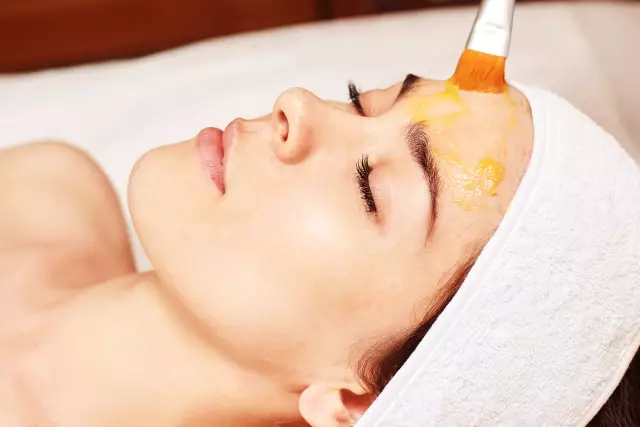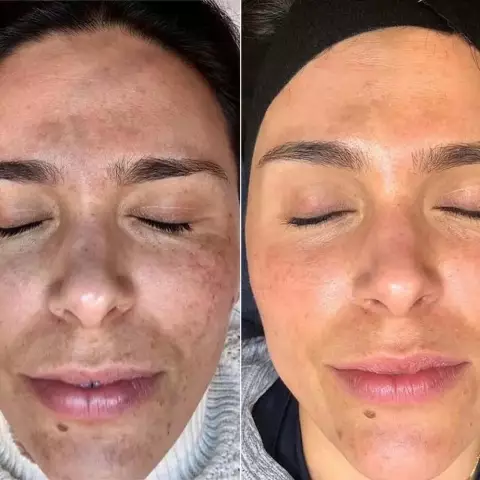- Author Rachel Wainwright [email protected].
- Public 2023-12-15 07:39.
- Last modified 2025-11-02 20:14.
Chemical peeling

Chemical peeling is called a burn (damage) to the layers of the dermis and epidermis. As a result of damage to the skin, the process of renewal (regeneration) of skin tissues starts. For chemical peels, glycolic, salicylic, mandelic and trichloroacetic acids, as well as fruit acids, are commonly used. Many reviews of chemical peeling say that this procedure helps to rejuvenate the skin, eliminate stretch marks and scars, acne, and pigmentation. The facial skin after chemical peeling becomes light and smooth, acquires a healthier and younger look.
Types of chemical peels
Distinguish between deep, middle and superficial peeling. The depth of the procedure depends on the exposure time and the agent used.
Superficial chemical peeling is the safest and most easily tolerated type of peeling. Superficial peeling is most often performed to correct and prevent age-related skin changes. Alpha hydroxy acids (fruit acids) are commonly used to perform this cosmetic procedure. These include malic, citric, lactic and glycolic acids. In cosmetology, glycolic acid is most widely used. The high penetrating power is due to the small size of the glycolic acid molecules.
With regular application of the surface peeling procedure, fine wrinkles are smoothed out, age spots become less noticeable, and large pores tighten.
Superficial chemical peeling lasts from ten minutes to half an hour. The procedure usually consists of four to ten sessions. Most often it is painless, only sometimes the patient can feel a burning sensation and tingling. The interval between sessions is one to two weeks.
Medium peeling helps to correct scars, wrinkles, stretch marks (striae). During the procedure, the basement membrane of the skin is not damaged, the effect occurs over the entire depth of the epidermis.
With deep facial peeling, all layers of the epidermis are exposed. The structure of the basement membrane is disturbed during this procedure. Deep chemical face peeling is the most radical of all types of peeling. This procedure can be compared to plastic surgery performed under general anesthesia. For this procedure, phenol or trichloroacetic acid is most often used.
Indications for the use of chemical peels
Chemical peeling is used to prevent skin aging, treat problematic oily skin, acne, papillovirus infection, as well as eliminate keratomas, hyperpigmentation, and correct age-related cosmetic defects - wrinkles, folds, aging skin. Also, the peeling procedure is used in preparation for deep mechanical peeling of the skin or for plastic surgery.
Chemical peeling technique

The indications for this procedure, the number of sessions, the concentration and type of acid used are determined by the doctor. At the beginning of the procedure, the skin is cleaned with special solutions to normalize acidity and degrease. Then acid is applied to the skin in an even layer and neutralized with a special solution.
An important point is facial skin care after chemical peeling. The effect of facial rejuvenation after peeling is very noticeable, but the procedure itself is considered quite traumatic. The reaction to the peeling procedure is individual. It depends on the type of acid, skin type and exposure time.
Home chemical peels
Chemical peels at home can be carried out with preparations with a low concentration of fruit acids (4-10%). Before starting the procedure, it is necessary to test the skin for acid tolerance.
Peeling at home is not recommended in case of skin hypersensitivity, in the presence of inflammatory processes and neoplasms on the skin. You should not carry out this procedure at home with cardiovascular and mental illness. Peeling should also not be done in summer, as the interaction of ultraviolet rays with acids can promote skin hyperpigmentation.
Found a mistake in the text? Select it and press Ctrl + Enter.






